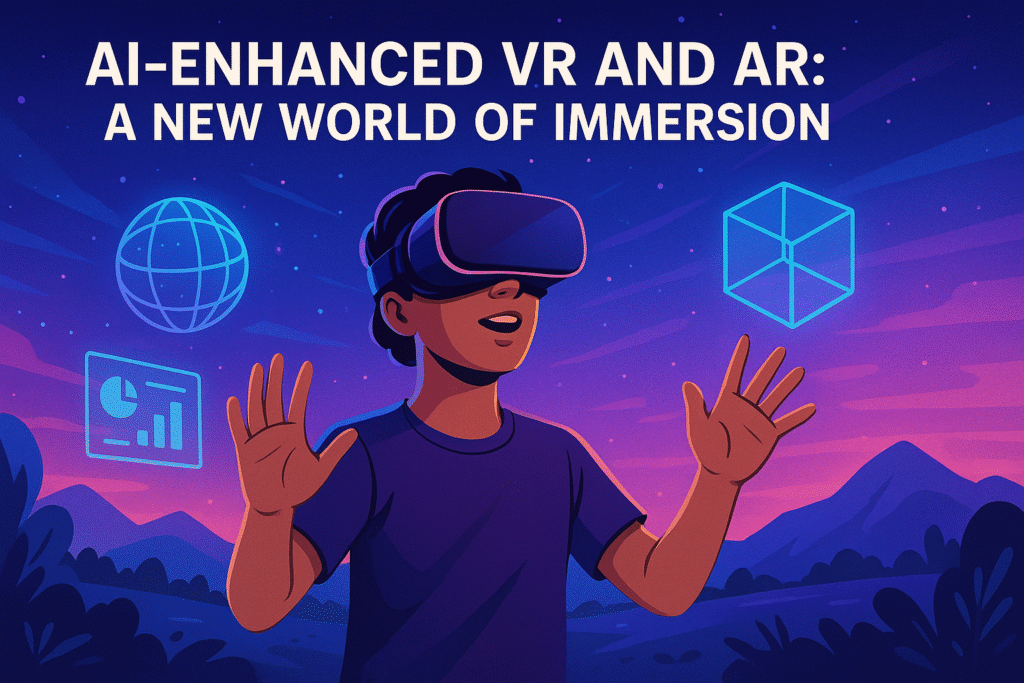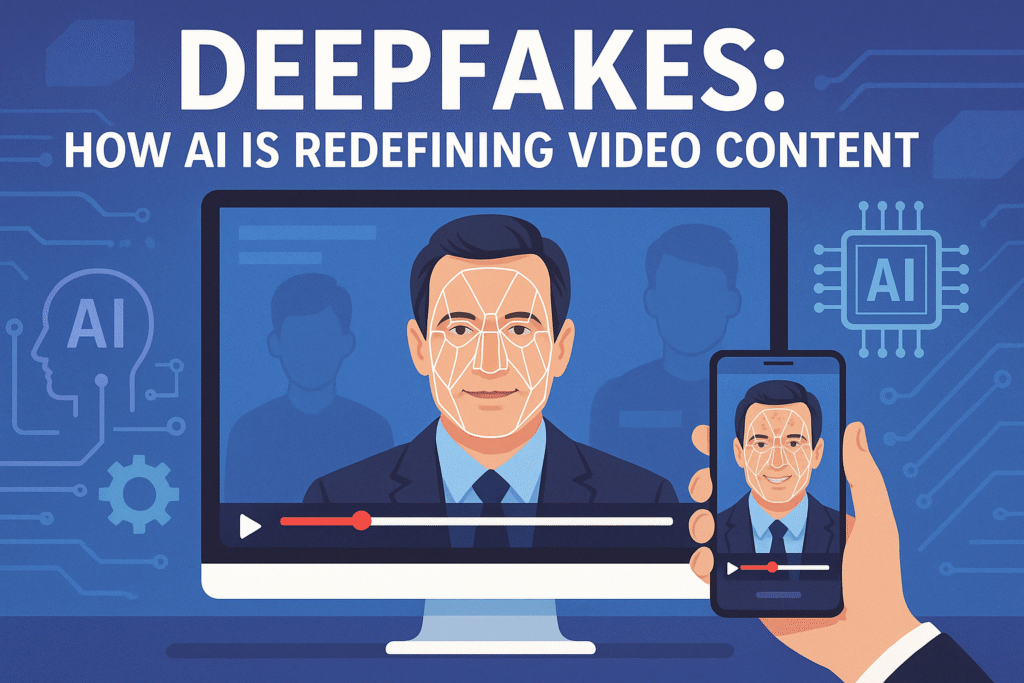🧠 AI-Enhanced VR and AR: A New World of Immersion
Virtual Reality (VR) and Augmented Reality (AR) have already changed the way we experience digital content, but when combined with artificial intelligence (AI), they’re creating an entirely new level of immersion. AI-enhanced VR and AR are transforming how we interact with the digital world, making it more intuitive, interactive, and lifelike than ever before.
At AiBlogQuest.com, we explore how AI is elevating VR and AR technologies, opening up new possibilities for gaming, entertainment, education, and beyond.
🧠 What is AI-Enhanced VR and AR?
AI-enhanced VR and AR are immersive technologies that integrate artificial intelligence to create a more dynamic, adaptive, and responsive virtual environment. Here’s how they work:
-
VR (Virtual Reality) creates a fully immersive, digital environment where users can interact with virtual objects and spaces.
-
AR (Augmented Reality) overlays digital content onto the real world, enhancing what you see with virtual elements.
By adding AI into the mix, these technologies can now learn and adapt to the user’s behavior in real-time. AI can create more natural interactions, predict user actions, and even generate content based on the user’s environment.
🌐 How AI Is Transforming VR and AR Immersion
AI is revolutionizing both VR and AR by making experiences more personalized and interactive. Here’s how AI is shaping the future of immersive technologies:
1. Intelligent Environment Adaptation
AI can make VR and AR environments more reactive to the user’s actions. For example, in a VR game, AI can adapt the environment based on the player’s behavior, adjusting difficulty levels, enemies, and scenarios to match their skills or preferences. In AR applications, AI can analyze the real-world environment and intelligently integrate digital content that fits seamlessly into the user’s surroundings.
2. Advanced Object Recognition
One of the key features of AI-enhanced AR is its ability to recognize objects and context in the real world. Through machine learning and computer vision, AR apps powered by AI can identify real-world objects and offer context-aware interactions. For instance, AR can overlay detailed information on a product or guide users on how to interact with real-world objects in innovative ways.
3. Personalized Experiences
AI allows VR and AR systems to learn from user behavior and adapt experiences accordingly. In VR games, this could mean changing the storyline or characters based on past interactions, while in AR, it could personalize the information shown based on a user’s interests or needs. For example, an AI-powered AR app could suggest places to visit in a city or provide customized learning experiences based on the user’s preferences.
4. Natural Language Processing (NLP) and AI
AI-powered VR and AR systems are increasingly using Natural Language Processing (NLP) to enable voice-based interactions. Instead of relying solely on controllers or touch, users can speak to their virtual environment, and the AI will interpret their commands and respond accordingly. This opens up a world of possibilities in gaming, training, and social applications.
5. Emotion Recognition and Response
AI can enhance immersion further by recognizing emotions through facial recognition or biometric data. In VR and AR environments, this means AI can adjust the experience based on the user’s emotional state. For instance, in a VR game, AI can monitor the player’s anxiety level and adjust the intensity of the experience, making it more enjoyable and comfortable.
🎯 Benefits of AI-Enhanced VR and AR
✅ More Interactive Experiences: AI makes VR and AR more engaging by responding in real-time to user actions and preferences.
✅ Personalized Content: AI enhances the experience by adapting to individual preferences, making interactions feel more tailored and immersive.
✅ Smarter Environments: AI allows VR and AR environments to respond dynamically to the user’s behavior, offering more natural and realistic interactions.
✅ Broader Applications: With AI, VR and AR can be used in a wider range of industries, including education, healthcare, gaming, and entertainment.
⚠️ Challenges and Concerns with AI-Enhanced VR and AR
While the potential for AI in VR and AR is immense, there are some concerns and challenges:
❌ Data Privacy: The use of AI in VR and AR often involves collecting user data, which raises concerns about privacy and security. Users need to be aware of how their data is being used and protected.
❌ High Costs: AI-powered VR and AR systems can be expensive to develop and implement, which may limit their availability to mainstream users.
❌ Over-dependence on Technology: As AI makes VR and AR more lifelike, there is a risk of people becoming overly reliant on immersive digital worlds, leading to possible social isolation or addiction.
🌐 The Future of AI-Enhanced VR and AR
The future of AI-enhanced VR and AR looks bright, with AI continually pushing the boundaries of what’s possible. As AI improves, we can expect more immersive, interactive, and personalized virtual environments. These technologies will not only change gaming and entertainment but will also have a significant impact on sectors like education, healthcare, and business.
In the coming years, we’ll likely see AI-driven VR and AR become more accessible, affordable, and ubiquitous, leading to new ways of learning, playing, and interacting with the world around us.
🔗 Useful Links
🌐 Resources
❓ FAQ – AI-Enhanced VR and AR
Q1: How does AI enhance VR and AR experiences?
AI enhances VR and AR by adapting environments based on the user’s behavior, recognizing real-world objects, offering personalized interactions, and responding to emotions in real-time.
Q2: Can AI create truly immersive virtual worlds?
Yes, AI allows VR and AR systems to create adaptive, intelligent virtual environments that react to user inputs and preferences, providing an immersive and personalized experience.
Q3: Are there privacy concerns with AI-powered VR and AR?
Yes, the use of AI in VR and AR requires the collection of user data, raising concerns about how that data is stored, protected, and used. It’s important for users to understand the privacy policies of the platforms they use.
🎬 Final Thoughts
AI-enhanced VR and AR are pushing the boundaries of immersive experiences, offering smarter, more interactive environments that adapt to users in real-time. Whether in gaming, education, healthcare, or entertainment, AI is transforming how we interact with digital worlds. While there are challenges to address, the future of AI-driven immersion is incredibly exciting.
For more insights on how AI is changing the world of immersive technologies, visit AiBlogQuest.com, where technology meets creativity.
🏷️ Tags:
AI in VR, AI-Enhanced AR, AI in Immersive Technologies, AI in Gaming, Augmented Reality, Virtual Reality, AI for Education, AI-Driven Content, Immersive Experiences, AiBlogQuest



